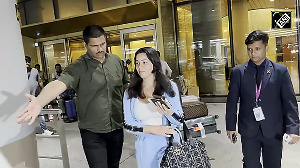M R Ahmed, president, Federation of Indian Export Organisations
The practice of giving export incentives is virtually universal, and India is no exception.
The only question that needs to be addressed is how best to structure the export incentives so as to make them compatible with World Trade Organisation regulations while, simultaneously, achieving the objective of export promotion.
A subsidy has been defined as a financial contribution conferring a benefit by government or any public body.
However, the Agreement on Subsidies and Countervailing Measures clearly mentions that "exemption of an exported product from duties or taxes borne by like products when destined for domestic consumption, or the remission of such duties in amounts not in excess of those that have accrued, shall not be deemed to be a subsidy".
I was surprised to see reports in some of the leading dailies that subsidy worth Rs 40,000 crore (Rs 400 billion) was given in 2003-04. The figure quoted refers to the duty forgone under various export promotion schemes. The break-up is as follows:
-
DEPB: Rs 11,536 crore
-
Advance licence: Rs 10,134 crore
-
EOUs/ EHTP/ STP: Rs 94,224 crore
-
EPCG: Rs 3,399 crore
-
Drawback: Rs 3,058 crore
-
Others: Rs 1,753 crore
-
Total: Rs 39,704 crore
The total duty forgone as a percentage of exports is 13.6 per cent, since our total exports during 2003-04 were Rs 2,91,582 crore (Rs 2,915.82 billion).
Considering average excise duty is 16 per cent and average customs duty is about 20 per cent (during 2003-04), the figure of 13.6 per cent reflects a correct picture (of course, under a few schemes, the Cenvat facility is available, which may push the figure of 13.6 per cent a little higher).
Moreover, each country gives exemption on the inputs used in export products and, therefore, such exemptions should not be called a subsidy since they are not conferring any benefit to exporters. These instruments are rather for refunding the duties after a time gap, and thus the exporter has to bear the carrying cost.
I personally think that as exports start to grow at 18 to 20 per cent a year, the figure of approximately Rs 40,000 crore may also double in the next five years, after accounting for duty reduction and movement up the value chain.
The only scheme providing export subsidy to Indian exporters was that which exempted export profits from income tax. And the scheme has been phased out from the current fiscal year.
Some of the schemes operated by the government have been countervailed in subsidy investigations, but these were, by and large, on technical grounds and due to the absence of an in-built verification system.
In a country in which most exports are manufactured by small and medium enterprises and tiny and cottage sectors, elaborate consumption data cannot be maintained -- a prerequisite in any subsidy investigation.
We should also remember that Indian exporters face innumerable bottlenecks such as higher electricity tariff, inflexibile labour laws, unrebated state levies, poor infrastructure and so on.
To make our products competitive, we have to remove these bottlenecks. However, it is easier said than done. A little padding was earlier available under Section 80-HHC and its withdrawal has, consequently, made the going tough.
One of the alternatives could be to provide exemption to thrust sectors across the board rather than linking it to exports only.
Some Saarc countries have given 100 per cent income tax exemption to textiles, and they are already making an impression in the international markets.
The commerce minister could advocate income-tax exemption for textiles, handloom, leather and electronic hardware to achieve the twin objectives of employment generation and product competitiveness.
Moreover, since the subsidy discipline does not apply to agriculture, we should consider giving fiscal support to agricultural exports. This is more relevant in the context of higher agricultural subsidies available to farmers in the European Union and the US.
The share of agricultural products in our exports has dropped from 19.4 per cent in 1990-91 to 11.7 per cent in 2003-04.
To conclude, by and large, no subsidy is provided to Indian exporters. The government only provides refund of the duties on the inputs used in the export products, or suspends the duties on imported inputs required for export production.
The introduction of a uniform, single value-added tax could usher in an era that will provide for a rebate of all kinds of duties, which would dispense with the need for multiple schemes.
Prabir Sengupta, director, Indian Institute of Foreign Trade
The conventional arguments for export subsidy have been that it neutralises tariff distortion or capital market imperfections and helps achieve export expansion and diversification.
Export credit or insurance subsidies aim at meeting the capital market imperfections. In addition, provisions for market development or market information studies or subsidies for upgradation of technology have also been part of the export promotion packages.
The East Asian experience, particularly that of South Korea, has been referred to as a case where export subsidies played a critical role in stimulating exports.
I must add that most of these arguments have their critics, eminent ones at that. But the arguments remain substantially valid in an imperfect world market where developed and developing countries alike have put non-tariff protectionist measures as also selective tariff barriers.
In the Indian context, the high transaction costs (estimated to be 18 per cent) as also non-refundability of charges like state sales tax, octroi duties further impose additional costs for exporters. In the absence of a comprehensive value-added tax system, exporters face costs that are not automatically neutralised. These costs put an additional burden on Indian exporters.
We have today a number of export promotion and market development schemes. The total customs duty forgone for all these schemes such as advance licence, duty entitlement pass book, export promotion capital goods, duty drawbacks and so on has been estimated at Rs 40,000 crore during 2003-04.
The total export during the same period has been Rs 2,90,000 crore (Rs 2,900 billion). Revenue forgone thus accounts for a little less than 14 per cent of the total exports. All over the world, whether in a developed or developing country, exporters are allowed full duty remissions.
As the percentage indicated above is much lower than the average customs duty in the country, the total revenue forgone cannot be considered to be too high on a macro basis, if we accept the well-established philosophy that the price of the export product is not to be loaded with any tax element and that our exporters are not disadvantaged vis-à-vis their competitors for not having access to raw materials, inputs or machineries of international quality at international prices.
Improved targeting of export subsidies along with the broad economic reforms have pushed up our export growth rate. The decadal growth rate of Indian exports in dollar terms was around 10 per cent in the 1990s as against world growth rate of about 6 per cent.
The current growth rates are similarly encouraging and providing subsidy in a focused manner for products with revealed comparative advantage as also with real comparative advantage based on our potentialities will have the maximum efficacy.
A comprehensive exercise was done earlier to prepare an optimum product country mix that needs our special attention. The list needs to be fine-tuned, but the framework remains valid and the need for connecting our subsidy regime to such a framework continues to be paramount.
A point has quite often been made that there is large-scale misuse of export subsidy. There is no evidence to substantiate this.
According to one government estimate, cases of export fraud or misuse of various incentive schemes detected during 2002-03 involved an amount of only Rs 63 crore (Rs 630 million), which is less than 1 per cent of the total export during that year.
The extent of infirmity cannot be any better in any scheme, however administratively or economically sound it is.
There is, nonetheless, a need for procedural simplification as also a strong administrative machinery for enforcement.
While exporters have complained of delays and duality of control, inadequate enforcement measures and inability to punish quickly and severely the delinquents create avoidable doubts about the subsidy regime.
IT can play an important role in this regard and the EDI Linkages between customs authorities, banks, ports and so on will improve the efficacy of subsidies.
A word about subsidies being WTO compatible. If they are not compatible, the subsidies become actionable and the entire subsidy becomes counter-productive. This is an area that will require constant attention.
An export promotion strategy depends upon a number of policy issues like the real effective exchange rate, overall tariff regime and so on.
But focused export subsidies will have to remain an important ingredient in such a strategy, particularly when we have launched an ambitious foreign trade policy.






 © 2025
© 2025